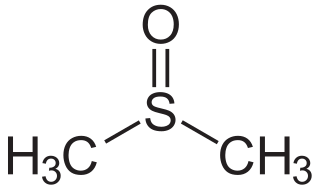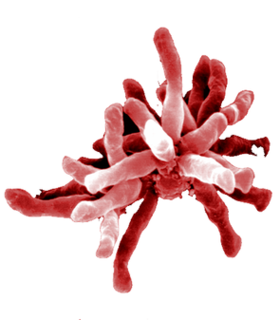Related Research Articles

Dimethyl sulfoxide (DMSO) is an organosulfur compound with the formula (CH3)2SO. This colorless liquid is an important polar aprotic solvent that dissolves both polar and nonpolar compounds and is miscible in a wide range of organic solvents as well as water. It has a relatively high boiling point. DMSO has the unusual property that many individuals perceive a garlic-like taste in the mouth after contact with the skin.
The purple sulfur bacteria (PSB) are part of a group of Proteobacteria capable of photosynthesis, collectively referred to as purple bacteria. They are anaerobic or microaerophilic, and are often found in stratified water environments including hot springs, stagnant water bodies, as well as microbial mats in intertidal zones. Unlike plants, algae, and cyanobacteria, purple sulfur bacteria do not use water as their reducing agent, and therefore do not produce oxygen. Instead, they can use sulfur in the form of sulfide, or thiosulfate (as well, some species can use H2, Fe2+, or NO2−) as the electron donor in their photosynthetic pathways. The sulfur is oxidized to produce granules of elemental sulfur. This, in turn, may be oxidized to form sulfuric acid.
Methylsulfonylmethane (MSM) is an organosulfur compound with the formula (CH3)2SO2. It is also known by several other names including methyl sulfone and dimethyl sulfone (DMSO2). This colorless solid features the sulfonyl functional group and is considered relatively inert chemically. It occurs naturally in some primitive plants, is present in small amounts in many foods and beverages, and is marketed as a dietary supplement. It is sometimes used as a cutting agent for illicitly manufactured methamphetamine. It is also commonly found in the atmosphere above marine areas, where it is used as a carbon source by the airborne bacteria Afipia.

The Rhizobiaceae is a family of proteobacteria comprising multiple subgroups that enhance and hinder plant development. Some bacteria found in the family are used for plant nutrition and collectively make up the rhizobia. Other bacteria such as Agrobacterium tumefaciens and A. rhizogenes severely alter the development of plants in their ability to induce crown galls or hairy roots found on the stem. The family has been of an interest to scientists for centuries in their ability to associate with plants and modify plant development. The Rhizobiaceae are, like all Proteobacteria, Gram-negative. They are aerobic, and the cells are usually rod-shaped. Many species of the Rhizobiaceae are diazotrophs which are able to fix nitrogen and are symbiotic with plant roots.

The Rhizobiales are an order of Gram-negative Alphaproteobacteria.

Purple bacteria or purple photosynthetic bacteria are Gram-negative proteobacteria that are phototrophic, capable of producing their own food via photosynthesis. They are pigmented with bacteriochlorophyll a or b, together with various carotenoids, which give them colours ranging between purple, red, brown, and orange. They may be divided into two groups – purple sulfur bacteria and purple non-sulfur bacteria (Rhodospirillaceae). Purple bacteria are anoxygenic phototrophs widely spread in nature, but especially in aquatic environments, where there are anoxic conditions that favor the synthesis of their pigments.

Dimethylsulfoniopropionate (DMSP), is an organosulfur compound with the formula (CH3)2S+CH2CH2COO−. This zwitterionic metabolite can be found in marine phytoplankton, seaweeds, and some species of terrestrial and aquatic vascular plants. It functions as an osmolyte as well as several other physiological and environmental roles have also been identified. DMSP was first identified in the marine red alga Polysiphonia fastigiata.
Dimethyl sulfide (DMS) or methylthiomethane is an organosulfur compound with the formula (CH3)2S. Dimethyl sulfide is a flammable liquid that boils at 37 °C (99 °F) and has a characteristic disagreeable odor. It is a component of the smell produced from cooking of certain vegetables, notably maize, cabbage, beetroot, and seafoods. It is also an indication of bacterial contamination in malt production and brewing. It is a breakdown product of dimethylsulfoniopropionate (DMSP), and is also produced by the bacterial metabolism of methanethiol.
Nitrobacter is a genus comprising rod-shaped, gram-negative, and chemoautotrophic bacteria. The name Nitrobacter derives from the Latin neuter gender noun nitrum, nitri, alkalis; the Ancient Greek noun βακτηρία, βακτηρίᾱς, rod. They are non-motile and reproduce via budding or binary fission. Nitrobacter cells are obligate aerobes and have a doubling time of about 13 hours.
Microbial metabolism is the means by which a microbe obtains the energy and nutrients it needs to live and reproduce. Microbes use many different types of metabolic strategies and species can often be differentiated from each other based on metabolic characteristics. The specific metabolic properties of a microbe are the major factors in determining that microbe's ecological niche, and often allow for that microbe to be useful in industrial processes or responsible for biogeochemical cycles.
The Class Gammaproteobacteria belongs to the Proteobacteria phylum and contains about 250 genera, which makes it the most genera-rich taxa of the Prokaryotes. Several medically, ecologically, and scientifically important groups of bacteria belong to this class. It is composed by all Gram-negative microbes and is the most phylogenetically and physiologically diverse class of Proteobacteria. The word Gammaproteobacteria comes from three Greek words: the Greek letter "gamma" (γ) meaning "changeable", the word proteakos (πρωτεϊκός) "little stick", and βακτήριον, that means "bacterium", so it means "changeable little stick bacterium". The name refers to Proteus, the Greek sea god who could change his shape. These microorganisms can live in several terrestrial and marine environments, in which they play various important roles, including extreme environments like the hydrothermal vents. They generally have different shapes, like rods, curved rods, cocci, spirilla, and filaments and include free living bacteria, biofilm formers, commensals and symbionts, some also have the distinctive trait of being bioluminescent. Metabolisms found in the different genera are very different; there are both aerobic and anaerobic species, chemolithoautotrophics, chemoorganotrophics, photoautotrophs and heterotrophs.
Afipia is a genus of bacteria from the family of Bradyrhizobiaceae.

Rhodopseudomonas palustris is a rod-shaped gram-negative purple non-sulfur bacterium, notable for its ability to switch between four different modes of metabolism.

Vanadium nitrogenase is a key enzyme for nitrogen fixation found in nitrogen-fixing bacteria, and is used as an alternative to molybdenum nitrogenase when molybdenum is unavailable. Vanadium nitrogenases are an important biological use of vanadium, which is uncommonly used by life. An important component of the nitrogen cycle, vanadium nitrogenase converts nitrogen gas to ammonia, thereby making otherwise inaccessible nitrogen available to plants. Unlike molybdenum nitrogenase, vanadium nitrogenase can also reduce carbon monoxide to ethylene, ethane and propane but both enzymes can reduce protons to hydrogen gas and acetylene to ethylene.
Sphingomonas yanoikuyae is a short rod-shaped, strictly aerobic, Gram-negative, non-motile, non-spore-forming, chemoheterotrophic species of bacteria that is yellow or off-white in color. Its type strain is JCM 7371. It is notable for degrading a variety of aromatic compounds including biphenyl, naphthalene, phenanthrene, toluene, m-, and p-xylene. S. yanoikuyae was discovered by Brian Goodman on the southern coast of Papua New Guinea. However, Sphingomonas have a wide distribution across freshwater, seawater, and terrestrial habitats. This is due to the bacteria’s ability to grow and survive under low-nutrient conditions as it can utilize a broad range of organic compounds.
Afipia birgiae is a species in the Afipia bacterial genus. It is a gram-negative, oxidase-positive rod in the alpha-2 subgroup of the class Proteobacteria. It is motile by means of a single flagellum. Its type strain is 34632T.
Rhodopseudomonas harwoodiae is a bacterium from the genus of Rhodopseudomonas.
Rhodoplanes is a phototrophic genus of bacteria. Rhodoplanes produces hopanoids like diplopterol, tetrahymanol, 2-methyldiplopterol, 2-methyltetrahymanol, bacteriohopanetetrol, bacteriohopaneaminotriol and carotenoids like spirilloxanthin, rhodopin, anhydrorhodovibrin, 1,1′-dihydroxylycopene and 3,4,3′,4′-tetrahydrospirilloxanthin
Tardiphaga is a genus of bacteria from the family of Bradyrhizobiaceae.
Rhodopseudomonas parapalustris is a rod-shaped, budding phototrophic and motile bacterium from the genus of Rhodopseudomonas which has been isolated from soil and freshwater sediments in India.
References
- ↑ "List of Prokaryotic Names with Standing in Nomenclature". Archived from the original on 27 April 2012. Retrieved 20 July 2010.
- ↑ De Meyer, S. E.; Coorevits, A.; Willems, A. (2012). "Tardiphaga robiniae gen. nov., sp. nov., a new genus in the family Bradyrhizobiaceae isolated from Robinia pseudoacacia in Flanders (Belgium)". Systematic and Applied Microbiology. 35 (4): 205–14. doi:10.1016/j.syapm.2012.02.002. PMID 22444281.
- ↑ "Variibacter". www.uniprot.org.
- ↑ Defeng Xing; Yi Zuo; Shaoan Cheng; John M. Regan & Bruce E. Logan (2008). "Electricity Generation by Rhodopseudomonas palustris DX-1". Environ. Sci. Technol. 42 (11): 4146–51. Bibcode:2008EnST...42.4146X. doi:10.1021/es800312v. PMID 18589979.
- ↑ Natasha DeLeon-Rodriguez, others (full list) (December 19, 2012). "Microbiome of the upper troposphere: Species composition and prevalence, effects of tropical storms, and atmospheric implications". Proceedings of the National Academy of Sciences. 110 (7): 2575–2580. doi:10.1073/pnas.1212089110. PMC 3574924 . PMID 23359712.
Based on the taxonomical classification of the SSU rRNA gene sequences recovered, Afipia spp. (Alphaproteobacteria) comprised over 50% of the total communities sampled off the California coast and during the transit flights. (…) This group [Afipia] is commonly found in aquatic environments and is known to use dimethyl sulfone (DMSO2) as a sole carbon source. DMSO2 represents an intermediate of the oxidation of dimethyl sulfide (DMS), which is commonly found in the marine atmosphere
(page 3 and 5 of 6, quotes slightly edited).